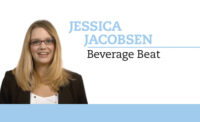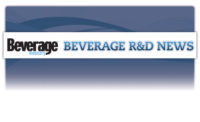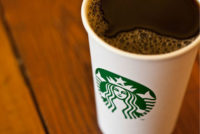![]()
New Products Take Center Stage in Dallas
Beverage Industry held its fifth annual New Products Conference
in Dallas last month, hosting a number of informational speakers and giving
attendees a chance to show their stuff with a new products contest.
Contest leaders Stephen Goldstein of FoodThinque and Jamie Peracchi
of Fat Cat design got the creative juices flowing by leading an ideation session
that brought out several consumer needs ripe for new products. Throughout the
day-and-a-half conference, team members brainstormed, developed concept products
and voted to determine the best (see sidebar for the winning idea).
Kim Feil, chief executive officer at Mosaic InfoForce,
Chicago, then got everyone down to business with a thorough look at the
challenges consumers and retailers pose to new products. Promising
categories last year, she said, were diet products, bottled water,
beer in certain retail segments, and liquor. Not-so-promising were line
extensions.
Feil also had a word of advice regarding partnering
with retailers and dealing with product churn, which is “If you
don’t manage that, the retailer will.”
Lance Collins, chief executive officer at Fuze
Beverages, Englewood Cliffs, N.J., discussed the problem of obesity in
America and the effect it’s having on new products. For its part,
Fuze has developed a line of white and green teas with half the calories of
regular drinks, and also has a lower-calorie kids line on the way.
John Carson, chairman and chief executive officer of
Marbo Inc., Chicago, tackled the challenges of successful product launches
and suggested beverage-makers find a hole in the consumer experience and
fill it. He used as an example the way
juice-makers extended their products beyond breakfast, increasing sales by
filling other daypart needs.
He also said “being realistic is a very tough
thing to do,” and suggested companies define success and refer back
to that definition often.
Joan Schneider, president of Schneider &
Associates, Boston, recommended looking beyond
the beverage category for new product inspiration and looking beyond
traditional advertising for marketing a product. Influential consumers
— the ones who will discover a product and recommend it to their
family and friends, watch TV 14 percent less than the average consumer.
Experiential marketing, she says, is more likely to catch these
trend-setters.
Switch Beverage Co. Chief Executive Officer Bill
Hargis told attendees there were many different ways to go to market.
“You’re cheating yourself by not surveying the market and
asking who is the best distributor,” he said. For some companies, the
best distributor might not be the biggest or obvious choice. And, he said,
“Don’t handcuff yourself with
exclusive distribution rights.” Some
distributors do not serve certain accounts and exclusivity can lock you out
of those outlets.
Tom Vierhile, general manager at Marketing
Intelligence Service, Naples, N.Y., discussed the impact low-carb diets
have had on new products and on the nation as a whole. He compared the
trend to other diet fads of the past decade and suggested low-carb has
neared its peak. Other new product trends picked up by the company’s
Producscan tracker include cola beers, exotic flavors such as pomegranate
and blood orange, and coffee pods.
Marcel Nahm, director of marketing, Hispanic brands and
ingredients at Cadbury Schweppes Americas Beverages, Stamford, Conn.,
discussed changing American demographics, specifically Hispanic trends. He
outlined the trial and error the company went through marketing its Clamato
brand juice, and the “lightbulb moment” when it decided to
rebrand the product for Hispanic consumers.
Champion Lyte Beverages President Donna Bimbo talked
about the increasing sales of diet drinks, and said there is little need to
create demand; it’s already out there and just needs to be filled.
Bimbo’s company, based in Pompano Beach, Fla., produces Champion Lyte
no-calorie sports drinks, and she emphasized anyone creating a diet product
needs to keep in mind that it must be equal in flavor to a regular product
to compete.
James Tonkin, principal at TonkinConsulting,
Scottsdale, Ariz., walked through the creative development process,
suggesting ways companies can meet “real” functional needs and
“real” fortification issues. Products to watch, he said are licensed brands, charity tie-ins, organic drinks, high-impact
supplements, “true” sports drinks, dairy beverages,
next-generation energy drinks, probiotics, isoflavones, omega-3s and
vitamins.
Discussing the special place convenience stores occupy in a
time-crunched world, Debbie Wildrick, category manager, new product development,
non-alcohol beverages at 7-Eleven, said almost 50 percent of 7-Eleven’s sales
are single-serve beverages and 60 percent are beverages purchased with something
else. Wildrick says her company puts a strong emphasis on new products, preferring
to participate in their development. “The energy drink business is on fire”
in convenience stores, she says, and soft drinks trend higher than any other
food category for new product trial. But don’t come to her with a me-too product
— the company places a premium on innovation.
New twist on kids’ drinks
Tongue Twisters, a beverage
concept for children, was the winner of the Product Contest at the Beverage Industry New Products Conference. The product
is the brainchild of team members Jung Weil, director of communications and
creative services for the Glass Pack-aging Institute; Brendan Naulty, vice
president of sales and marketing for Ajinomoto Food Ingredients, LLC;
Thomas Sutherland, director, business unit beverages at Symrise Inc.;
Emmanuel Laroche, marketing manager at Symrise Inc. and Scott Garpow of
Pow! Innovations
Led by Stephen Goldstein, president of FoodThinque,
New York City, and Jamie Peracchi, principal at Fat Cat Design, Halifax,
Mass., each team was encouraged to develop a product that both met a need
of today’s consumers and created “food news”. The winning
product concept was an on-the-go nutritional beverage for kids that
encourages reading by including tongue-twisters on the back of the bottle
and encourages fun by turning the tongue different colors. The
nutrition-packed formulation was a blend of milk and fruit juice, and
proposed flavors for the product — each with a corresponding tongue
color — were Kiwi-Strawberry, Cherry and Mixed Berry.




